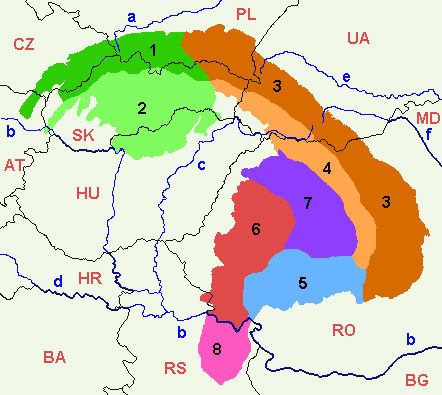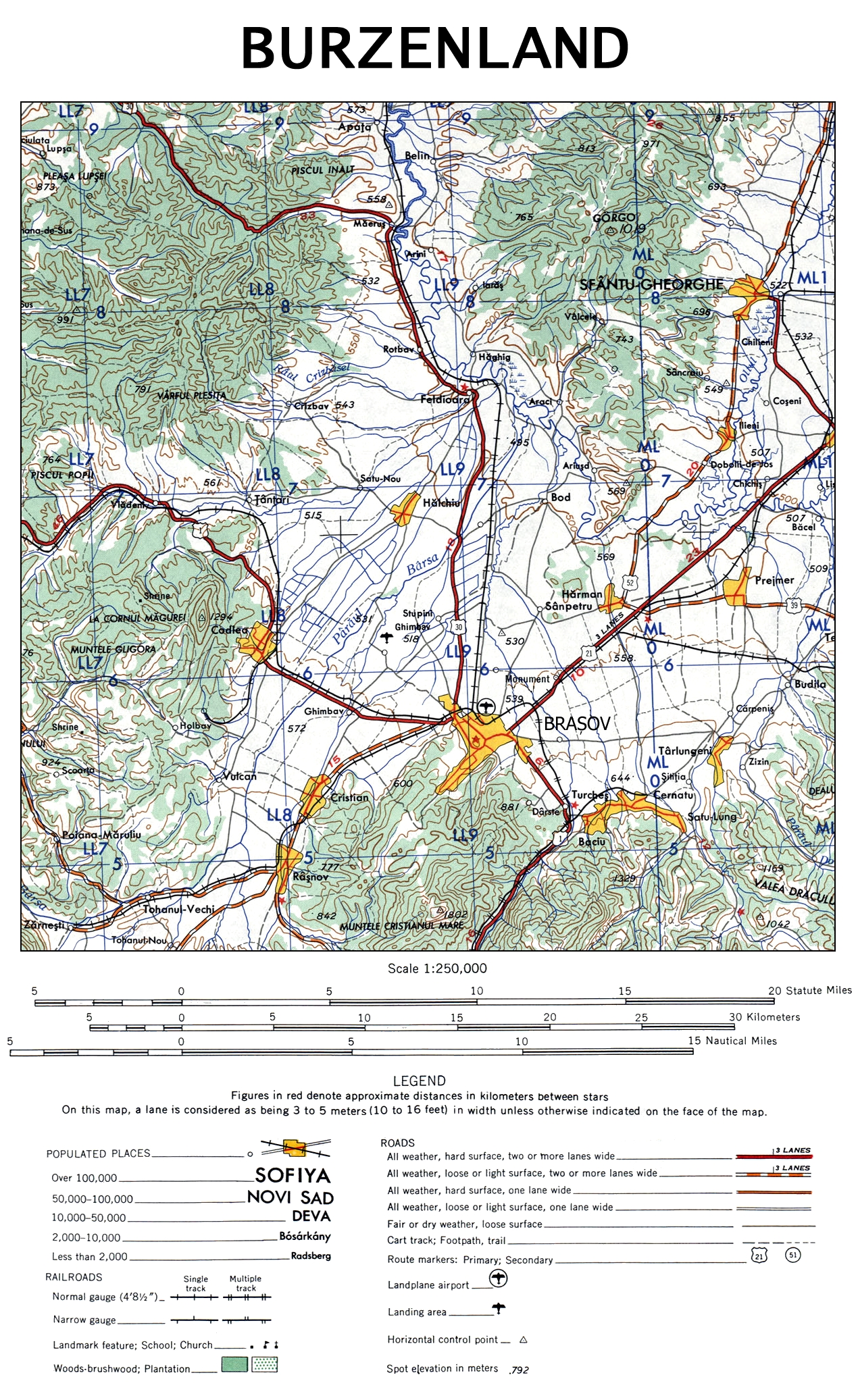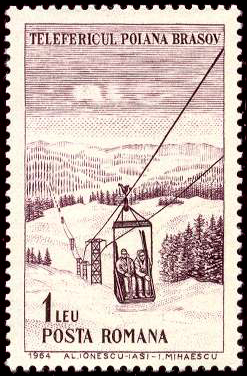|
Postăvarul Massif
The Postăvarul massif ( Transylvanian German ''Schuler'' and ''Schulerberg'') is a massif in Romania; it is part of the Romanian Carpathians, which in turn are part of the Carpathian Mountains range. The altitude of the highest peak, also named Postăvarul is 1799 metres. Geographically the Postăvarul Massif stands at the southern end of the grand arc of the Eastern Carpathians. Together with the neighboring Piatra Mare Massif it forms the Bârsei Mountains group, neighbouring the southern side of Țara Bârsei (Burzenland) depression. Poiana Brașov, one of the best known ski resorts in Romania, is located on the northern slopes of Postăvarul mountain. The peak of the mountain can be easily reached from the resort by cable car Cable car most commonly refers to the following cable transportation systems: * Aerial lift, such as aerial tramways and gondola lifts, in which the vehicle is suspended in the air from a cable ** Aerial tramway ** Chairlift ** Gondola lift *** Bi . ... [...More Info...] [...Related Items...] OR: [Wikipedia] [Google] [Baidu] |
Cetatea Râșnovului; Pe Fundal Masivul Postăvaru și Poiana Brașov
{{geodis ...
Cetatea may refer to several villages in Romania: * Cetatea, a village in Dobromir Commune, Constanța County * Cetatea, a village in Frătești Commune, Giurgiu County * Cetatea, a village in Căpreni Commune, Gorj County * Cetatea, a village in Rădoiești Commune, Teleorman County and to: * ''Cetatea Albă'', the Romanian name for Bilhorod-Dnistrovskyi, Odessa Oblast, Ukraine See also * Cetate (other) * Cetățuia (other) Cetățuia may refer to several villages in Romania: * Cetățuia, a village in Strugari Commune, Bacău County * Cetățuia, a village in Bărbulețu Commune, Dâmbovița County * Cetățuia, a village in Cioroiași Commune, Dolj County * Cetă� ... [...More Info...] [...Related Items...] OR: [Wikipedia] [Google] [Baidu] |
Transylvanian Saxons
The Transylvanian Saxons (german: Siebenbürger Sachsen; Transylvanian Saxon: ''Siweberjer Såksen''; ro, Sași ardeleni, sași transilvăneni/transilvani; hu, Erdélyi szászok) are a people of German ethnicity who settled in Transylvania (german: Siebenbürgen) in waves starting from the mid- 12th century until the mid 19th century. The legal foundation of the settlement was laid down in the Diploma Andreanum issued by King Andrew II of Hungary that is known for providing the first territorial autonomy hitherto in the history. The Transylvanian "Saxons" originally came from Flanders, Hainaut, Brabant, Liège, Zeeland, Moselle, Lorraine, and Luxembourg, then situated in the north-western territories of the Holy Roman Empire around the 1140s. After 1918 and the dissolution of Austria-Hungary, in the wake of the Treaty of Trianon, Transylvania united with the Kingdom of Romania. Consequently, the Transylvanian Saxons, together with other ethnic German sub-groups in newly e ... [...More Info...] [...Related Items...] OR: [Wikipedia] [Google] [Baidu] |
Massif
In geology, a massif ( or ) is a section of a planet's crust that is demarcated by faults or flexures. In the movement of the crust, a massif tends to retain its internal structure while being displaced as a whole. The term also refers to a group of mountains formed by such a structure. In mountaineering and climbing literature, a massif is frequently used to denote the main mass of an individual mountain. The massif is a smaller structural unit of the crust than a tectonic plate, and is considered the fourth-largest driving force in geomorphology. The word is taken from French (in which the word also means "massive"), where it is used to refer a large mountain mass or compact group of connected mountains forming an independent portion of a range. One of the most notable European examples of a massif is the Massif Central of the Auvergne region of France. The Face on Mars is an example of an extraterrestrial massif. Massifs may also form underwater, as with the Atlanti ... [...More Info...] [...Related Items...] OR: [Wikipedia] [Google] [Baidu] |
Romania
Romania ( ; ro, România ) is a country located at the crossroads of Central Europe, Central, Eastern Europe, Eastern, and Southeast Europe, Southeastern Europe. It borders Bulgaria to the south, Ukraine to the north, Hungary to the west, Serbia to the southwest, Moldova to the east, and the Black Sea to the southeast. It has a predominantly Temperate climate, temperate-continental climate, and an area of , with a population of around 19 million. Romania is the List of European countries by area, twelfth-largest country in Europe and the List of European Union member states by population, sixth-most populous member state of the European Union. Its capital and largest city is Bucharest, followed by Iași, Cluj-Napoca, Timișoara, Constanța, Craiova, Brașov, and Galați. The Danube, Europe's second-longest river, rises in Germany's Black Forest and flows in a southeasterly direction for , before emptying into Romania's Danube Delta. The Carpathian Mountains, which cross Roma ... [...More Info...] [...Related Items...] OR: [Wikipedia] [Google] [Baidu] |
Romanian Carpathians
The Romanian Carpathians ( ro, Carpații românești) are a section of the Carpathian Mountains, within the borders of modern Romania. The Carpathians are a "subsystem" of the Alps-Himalaya System and are further divided into "provinces" and "subprovinces". This is an overview of the geological subdivisions of the Romanian section of the Carpathian Mountains. The broadest divisions are shown in the map on the right. The last level of the division, i.e. the actual mountain ranges and basins, is usually called "units". The lowest-level detail for those units is maintained on separate pages. Naming conventions Traditional Romanian naming conventions differ from this list. In Romania, it is usual to divide the Eastern Carpathians in Romanian territory into three geographical groups (North, Centre, South), instead in Outer and Inner Eastern Carpathians. The Transylvanian Plateau is encircled by, and geologically a part of, the Carpathians, but it is not a mountainous region and ... [...More Info...] [...Related Items...] OR: [Wikipedia] [Google] [Baidu] |
Carpathian Mountains
The Carpathian Mountains or Carpathians () are a range of mountains forming an arc across Central Europe. Roughly long, it is the third-longest European mountain range after the Urals at and the Scandinavian Mountains at . The range stretches from the far eastern Czech Republic (3%) and Austria (1%) in the northwest through Slovakia (21%), Poland (10%), Ukraine (10%), Romania (50%) to Serbia (5%) in the south. "The Carpathians" European Travel Commission, in The Official Travel Portal of Europe, Retrieved 15 November 2016 The Carpathian ... [...More Info...] [...Related Items...] OR: [Wikipedia] [Google] [Baidu] |
Piatra Mare Mountains
{{Unreferenced, date=June 2019, bot=noref (GreenC bot) The Piatra Mare Mountains (Hungarian: ''Nagykőhavas'', German: ''Hohensteingebirge'') is a small mountain range in Brașov County, southeast of Brașov, Romania, and also close to the resort town of Predeal. Geologically the Piatra Mare Mountains stand at the southern end of the grand arc of the Eastern Carpathians, and between the inner ring of the Inner Eastern Carpathians and the outer ring of the Outer Eastern Carpathians. The neighbouring Postăvarul Massif is also positioned in the same transitional area. The range consists mainly of limestone and Carpathian flysch. The rock forms a predominantly north-south ridge, from which structured side combs extend to the west, and steep drops to the east. The highest peak, also called ''Piatra Mare'', stands at 1844 m (although sources differ on the exact height). Since 2015 the area was filed with recreational activities, a zip line that starts at the 7 steps cascades ... [...More Info...] [...Related Items...] OR: [Wikipedia] [Google] [Baidu] |
Burzenland
Țara Bârsei, Burzenland () or Barcaság is a historic and ethnographic area in southeastern Transylvania, Romania with a mixed population of Romanians, Germans, and Hungarians. Geography The Burzenland lies within the Southern Carpathians mountains ranges, bordered approximately by Apața in the north, Bran in the southwest and Prejmer in the east. Its most important city is Brașov. Burzenland is named after the stream Bârsa (''Barca'', ''Burzen'', 1231: ''Borza''), which flows into the Olt river. The Romanian word ''bârsă'' is supposedly of Dacian origin (''see List of Romanian words of possible Dacian origin''). History Middle Ages Based on archaeological evidence, it seems German colonization of the region started in the middle of the 12th century during the reign of King Géza II of Hungary. The German colonists from this region are attested in documents as early as 1192 when ''terra Bozza'' is mentioned as being settled by Germans (''Theutonici''). In 1211 ... [...More Info...] [...Related Items...] OR: [Wikipedia] [Google] [Baidu] |
Poiana Brașov
Poiana Brașov (, german: Schulerau; hu, Brassópojána) is a neighborhood of Brașov and a Romanian ski resort. After the 2010s modernization, the ski area has expanded from to and the slope’s length was increased from to . Most slopes now have snow cannons installed. In 2013, Poiana Brașov hosted figure skating, alpine skiing, and short track in the European Youth Olympic Winter Festival. The resort is located at about above sea level near the city of Brașov in Romania and it is easily accessible by road. There are regular buses operated by Brașov Transit ( RATBV) which serve the route between Brașov and Poiana Brașov (lines 20 and 100). The resort also runs minibusses to take visitors from hotels to the base of the ski runs from where they can hike or take a cable car to Cristianu Mare or Postăvaru summits. Poiana Brașov has a temperate-continental climate. The average temperature in summer is 20 °C and in winter -4 °C. There is a snow cover of ab ... [...More Info...] [...Related Items...] OR: [Wikipedia] [Google] [Baidu] |
Ski Resorts
A ski resort is a resort developed for skiing, snowboarding, and other winter sports. In Europe, most ski resorts are towns or villages in or adjacent to a ski area – a mountainous area with pistes (ski trails) and a ski lift system. In North America, it is more common for ski areas to exist well away from towns, so ski resorts usually are destination resorts, often purpose-built and self-contained, where skiing is the main activity. Ski resort Ski resorts are located on both Northern and Southern Hemispheres on all continents except Antarctica. They typically are located on mountains, as they require a large slope. They also need to receive sufficient snow (at least in combination with artificial snowmaking, unless the resort uses dry ski slopes). High concentrations of ski resorts are located in the Alps, Scandinavia, western and eastern North America, and Japan. There are also ski resorts in the Andes, scattered across central Asia, and in Australia and New Zealand. Ext ... [...More Info...] [...Related Items...] OR: [Wikipedia] [Google] [Baidu] |
Aerial Lift
An aerial lift, also known as a cable car or ropeway, is a means of cable transport in which ''cabins'', ''cars'', ''gondolas'', or open chairs are hauled above the ground by means of one or more cables. Aerial lift systems are frequently employed in a mountainous territory where roads are relatively difficult to build and use, and have seen extensive use in mining. Aerial lift systems are relatively easy to move and have been used to cross rivers and ravines. In more recent times, the cost-effectiveness and flexibility of aerial lifts have seen an increase of gondola lift being integrated into urban public transport systems. Types Cable Car A cable car (British English) or an aerial tramway, aerial tram (American English), uses one or two stationary ropes for support while a separate moving rope provides propulsion. The grip of an aerial tramway is permanently fixed onto the propulsion rope. Aerial trams used for urban transport include the Roosevelt Island Tramway ( New Yor ... [...More Info...] [...Related Items...] OR: [Wikipedia] [Google] [Baidu] |
Mountain Ranges Of Romania
A mountain is an elevated portion of the Earth's crust, generally with steep sides that show significant exposed bedrock. Although definitions vary, a mountain may differ from a plateau in having a limited summit area, and is usually higher than a hill, typically rising at least 300 metres (1,000 feet) above the surrounding land. A few mountains are isolated summits, but most occur in mountain ranges. Mountains are formed through tectonic forces, erosion, or volcanism, which act on time scales of up to tens of millions of years. Once mountain building ceases, mountains are slowly leveled through the action of weathering, through slumping and other forms of mass wasting, as well as through erosion by rivers and glaciers. High elevations on mountains produce colder climates than at sea level at similar latitude. These colder climates strongly affect the ecosystems of mountains: different elevations have different plants and animals. Because of the less hospitable terrain and ... [...More Info...] [...Related Items...] OR: [Wikipedia] [Google] [Baidu] |









